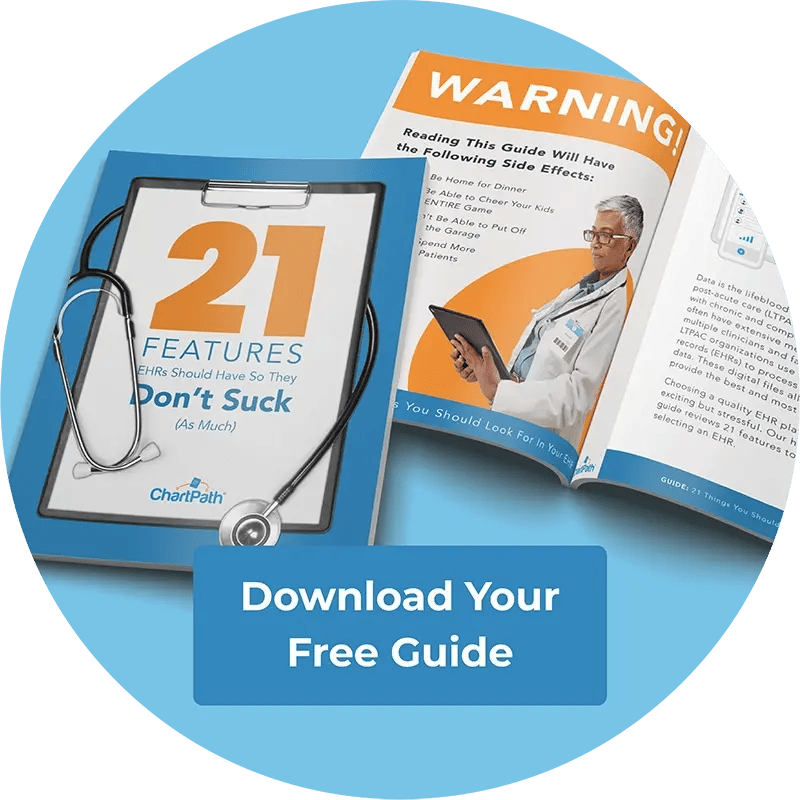EHR Security: Best Practices for Protecting Patient Data in Post-Acute Care

Electronic health records (EHR) reduce administrative workloads, foster clearer communication between clinicians, and even secure patient health information (PHI) better than paper documents — but they can still pose security risks. Phishing attempts, human errors, and poor cybersecurity practices can all leave your EHR data vulnerable to a threat, and the average data breach costs healthcare organizations $10.93 million — the highest of any industry. With so much at stake, healthcare organizations must implement strong EHR security measures to keep their patients — and their profits — safe from an attack.
This post will look at the importance of EHR security, especially for long-term post-acute care (LTPAC) facilities. We'll examine the leading risks and vulnerabilities in EHR systems, as well as some key practices that you can implement to bolster your EHR security posture, and how a robust EHR tool like ChartPath can help you pull it off.
Why EHR Security Matters in Post-Acute Care
From outdated software and phishing attempts to ransomware attacks and unauthorized access, healthcare organizations face cyber danger from multiple angles. The healthcare industry suffered more cyber attacks than any other major infrastructure sector in 2024, so organizations of all sizes must be diligent to protect their sensitive data.
Multiple compliance requirements also exist to regulate healthcare organizations' data security practices, and failure to comply with these standards could lead to a costly violation. For example, a HIPAA violation could cost a LTPAC facility up to $2.1 million depending on its severity. Taken together, the danger of a breach coupled with the cost of a compliance violation are too great for LTPAC facilities to ignore, so any reasonable security measure is worth the investment.
Common Risks and Vulnerabilities in EHR Systems
EHR security breaches can occur in many ways. Healthcare security professionals must be familiar with the threat landscape, so that they can protect your organization from the most common attacks. The main EHR security vulnerabilities that LTPAC facilities face are:
-
Unauthorized access, including hacking networks, accessing charts without the proper permissions, or entering physical spaces where medical records or servers are kept
-
Insider threats, including both compromised or disgruntled employees and those who fail to practice proper EHR security measures
-
Data breaches, including phishing attempts, ransomware attacks, Distributed Denial-of-Service (DDoS) attacks, or other hacking techniques
-
Device and network vulnerabilities, including unpatched software, missing updates, or unauthorized endpoints on your network
These vulnerabilities expose healthcare professionals to multiple risks, all of which carry additional hidden costs. For example, exposed patient data can not only lead to a compliance violation, but create legal liabilities and potential litigation as well. Some ransomware attacks have also frozen facilities' entire operations until payment is given, even putting patients in danger.
Core Principles of EHR Security
Despite the many threats to your EHR systems, there are several core principles that you can implement to protect your healthcare data. The primary EHR security principles are:
-
Confidentiality: Ensuring that only authorized personnel have access to your EHR data
-
Integrity: Ensuring that all data within your EHR systems is complete, consistent, and current
-
Availability: Ensuring that both patients and clinicians can access the EHR data that they need when they need it
To help LTPAC facilities implement these core principles, HIPAA and other regulations offer numerous frameworks and resources for developing their cybersecurity environment. The leading LTPAC EHR solutions like ChartPath come with built-in functionalities to elevate the confidentiality, integrity, and availability of your EHR data, so make sure your tool aligns with the core EHR security principles.
Best Practices for Safeguarding Patient Data
Using care coordination software with advanced EHR security functionalities can go a long way in strengthening your cybersecurity posture — but the right tool alone isn't enough. Maintaining your EHR security posture requires constant diligence, and synergy between your technology, people, and processes. A few best practices you can implement are:
-
Use strong authentication and access controls, to prevent unauthorized users from accessing sensitive patient data.
-
Implement data encryption for all EHR data at rest and in transit, preventing it from being viewed during storage and transmission.
-
Back up your data frequently, to prevent data loss and maintain your business continuity.
-
Apply regular updates and patches, to remediate vulnerabilities in legacy software.
-
Educate employees on EHR security topics, such as the importance of strong passwords and logging off, or how to spot a phishing attempt.
Another important EHR security measure is to promptly remove past employees' credentials. This reduces the number of users authorized to view patient data, and minimizes the risk of an insider threat.
Leveraging Technology for Enhanced EHR Security
While it takes more than technology to strengthen your EHR security, integrating modern cybersecurity solutions into your health IT environment is still a necessity. Leverage these technologies to enhance your EHR security posture:
-
Multi-factor authentication (MFA), such as passcodes, text or email messages, or biometrics, to prevent unauthorized access
-
Single sign-on (SSO), to simplify your access management processes
-
Intrusion detection and monitoring tools, such as Security Information and Event Management (SIEM) or Endpoint Detection Response (EDR)
-
Secure cloud-based solutions, to prevent attacks in the cloud
While many EHR solutions possess features like MFA or SSO to secure your patient data, the leading tools combine these with other functionalities that streamline your documentation processes. For example, ChartPath offers electronic case reporting (eCR) to automate data collection, minimize errors in your EHR systems, and facilitate more efficient reporting while keeping your data secure. The result is not only a stronger security posture, but an interoperable health IT environment that fosters superior patient care.
How ChartPath Supports EHR Security
Ransomware attacks, phishing attempts, human error — healthcare organizations face a wide number of threats to patient data security. Built-in safeguards like access control and data encryption can prevent your data from falling into the wrong hands, and compliance support tools ensure that your practices meet industry standards.
Having the right tool is essential for maintaining your cybersecurity posture, and leveraging an interoperable EHR solution is a great way to implement your data security best practices while streamlining your documentation workflows. Complete with data encryption functionalities at rest and in transit, automatic sign-out for stronger access control, and a host of other security features, ChartPath is a robust EHR platform that simplifies your data security framework — without adding friction for clinicians. Plus, it comes with a dedicated team of customer support specialists who stand by 24/7 to ensure your seamless user experience. See how ChartPath's platform can transform your post-acute care operations.
Blog Post Tags
EHRGet Awesome Content Delivered Straight to Your Inbox!
Posts by topic
- EHR
- Better Charting
- LTPAC
- AI
- RCM
- Compliance
- Healthcare Trends
- Press Release
- GUIDE
- reporting
- Artificial Intelligence
- Assisted Living
- Automation
- Behavioral Health
- Business
- Events
- General
- MIPS
- Operations
- Patient Outcomes
- Physician Billing Services
- Population Health Management
- Resumption of Care
- SNF
- TCM
- Value Based Care
- eCR
- interoperability
- partners
- regulations
- regulatory See All See Less




